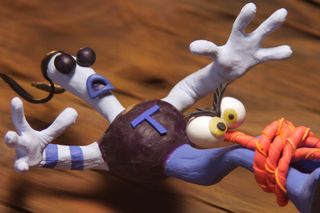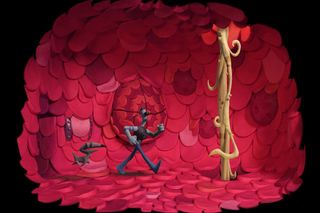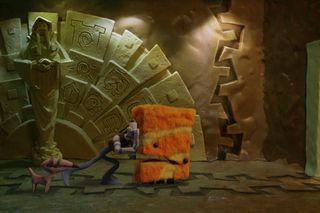Hands-on with Armikrog's incredible claymation world

Examined on paper, I can easily understand how point-and-click adventure game Armikrog accrued nearly a million dollars during its 2013 crowdfunding campaign: claymation visuals that defy expectation, an offbeat world full of talking dogs and fuzzy monsters, classic puzzle-solving that harkens back to adventure gaming’s golden age.
And then there’s Armikrog’s pedigree. Indie developer Pencil Test Studios’ core creative team consists of the same people who created Earthworm Jim and The Neverhood, the influential cult classic that pioneered Armikrog’s visual style and whose hero bares an uncanny resemblance to this new game’s protagonist, Tommynaut. That team in turn recruited some top voice talent—including Jon Heder (Napoleon Dynamite), Rob Paulsen (Pinky and the Brain), and Michael J. Nelson (Mystery Science Theater 3000)—to bring its quirky world to life.
According the the Magic Eight Ball of Expectation, all signs point to the game being excellent. After playing Armikrog on the E3 2015 showfloor last week, however, some concerns about the puzzle design brought me back down to earth. But let’s start with the good: The opening cinematic is short and sweet, elegantly framing Tommynaut and his bizarre canine companion Beak Beak as explorers who’ve crash landed on a hostile world. In fleeing from a silly-looking monster, they dive through a portal and a door slams shut behind them, leaving them no choice but to move forward through a series of rooms.

It’s a fairly basic setup, sure, but at least it avoids tedious exposition. Plus, it fast tracks players to the game’s true star: controlling characters in Armikrog’s world of clay. Screenshots alone may have already sold you on the aesthetic, but seeing it in action confounds all expectations. The animations are just so incredibly smooth and seamless, I could hardly believe the world I was seeing was actually reacting to my inputs. I know this isn’t the first game to utilize stop motion claymation, but I can’t remember anything else that looked quite this good doing it.
Appropriately, the world itself somehow feels like a natural extension of the art style, embracing all the weird and wonderful quirks of the medium. Tommynaut, for example, stores items by simply shoving them into his squishy clay stomach, and one of the later rooms I encountered during my demo seemed to melt into shape as I entered it. From the character design to the (somewhat limited) dialogue, everything about Armikrog effuses this very particular offbeat quality.
Unique as the world may be, however, the gameplay still fell flat—at least in the limited portion I was able to play. I experienced several moments that made me think, “Am I an idiot or was this actually not super well designed?” Maybe I am an idiot, but either way, that thought’s not a great sign. To give you an idea of what I mean: When I walked up to the Armikrog kiosk, the Indiecade rep manning the station was trying desperately to exit a tile puzzle that provided no instructions and that couldn’t be abandoned once players clicked into it. She eventually had to quit out of the game entirely.

Once I started a fresh game, the first puzzle consisted of picking up a lever, attaching it to a door, walking through an empty room, pushing a block back the way I came, and finally retrieving the original lever by sending Beak Beak through a hole in the wall. The only challenge came from the fact that I didn’t immediately notice the slot by the second door where I was meant to place the lever, which was more frustrating than challenging. It’s probably safe to assume Armikrog’s puzzles grow more sophisticated as the game progresses, but I didn't get to see evidence of that in the demo.
The biggest gaming news, reviews and hardware deals
Keep up to date with the most important stories and the best deals, as picked by the PC Gamer team.
Admittedly, the E3 showfloor is far from an ideal setting for first impressions, and the team at Pencil Test Studios still has a few months left to polish (good thing, considering the opening cutscene still consists largely of black and white placeholder sketches). We'll see the complete picture when Armikrog is out on August 18.
Most Popular

